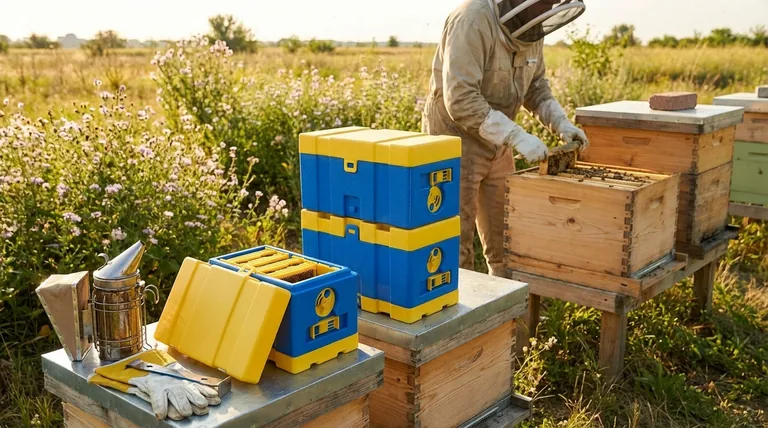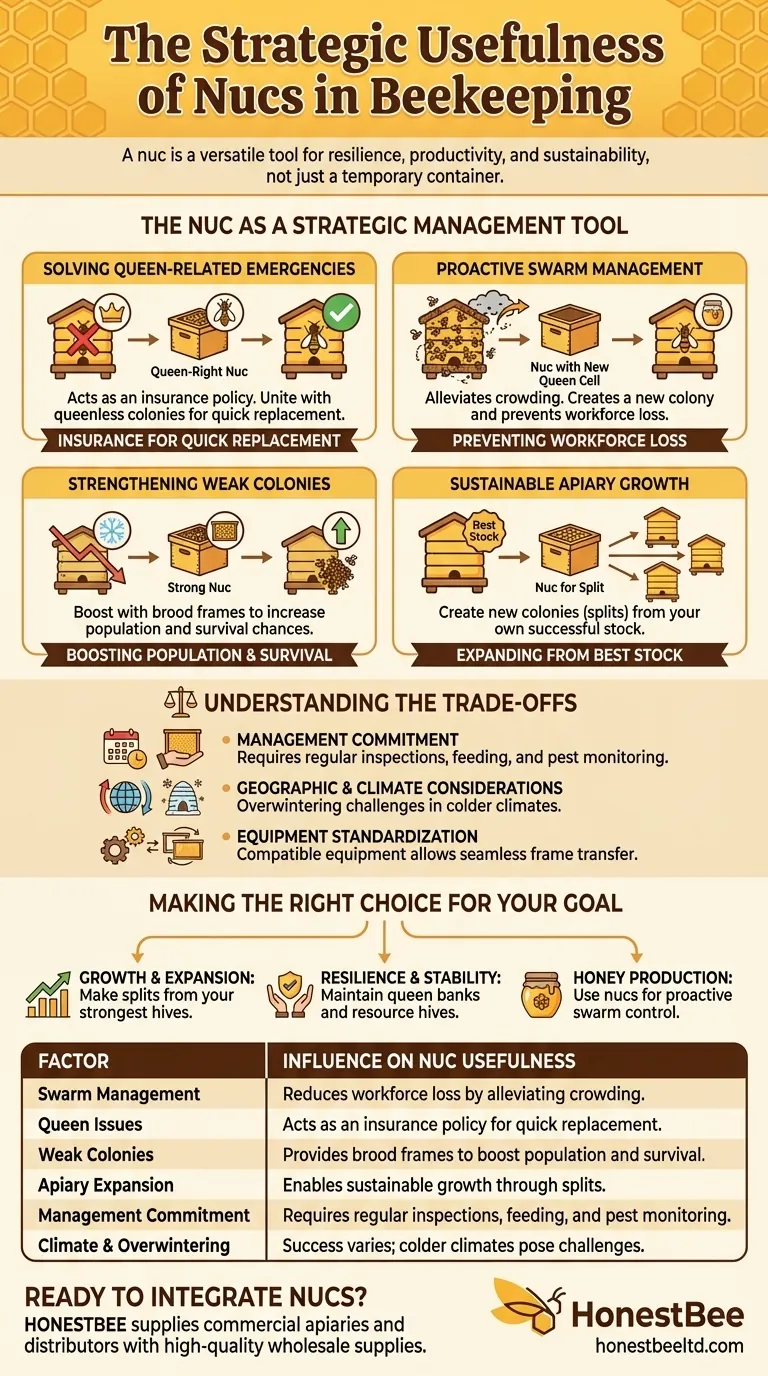At its core, a nucleus colony, or "nuc," is a versatile management tool whose usefulness is determined by your specific beekeeping goals. The primary factors influencing its value are your need to manage swarming, handle queen issues, strengthen weak colonies, or expand your apiary. A nuc is not just a small hive; it is a fundamental component for proactive and resilient beekeeping.
A nucleus colony should be viewed less as a temporary container for bees and more as a strategic asset. Its true value is realized when it is integrated into your apiary's year-round management plan to increase resilience, productivity, and sustainability.

The Nuc as a Strategic Management Tool
While often seen as just a way to buy or sell bees, the real power of a nuc lies in its use as a dynamic tool within an established apiary. It is your resource hub for solving common and costly beekeeping problems.
Solving Queen-Related Emergencies
A production colony that unexpectedly becomes queenless can lose weeks of productivity and may not survive.
A queen-right nuc on hand acts as an insurance policy. You can quickly unite the nuc with the queenless colony or transfer the queen herself, resolving the crisis in hours instead of weeks.
Proactive Swarm Management
Strong, crowded colonies are prone to swarming, which can drastically reduce your potential honey harvest as half the workforce leaves.
To prevent this, you can pull several frames of brood and bees from the booming colony and place them into a nuc box with a new queen cell or queen. This alleviates crowding in the primary hive while simultaneously creating a new, viable colony.
Strengthening Weak Colonies
A weak or slow-building colony, especially after winter, is vulnerable to pests and may fail to become productive.
You can "boost" this weak hive by giving it frames of sealed brood from a strong, healthy nuc. This infusion of new bees helps the struggling colony rapidly increase its population and chances of survival.
Sustainable Apiary Growth
Consistently buying new bees can be expensive. Using nucs is the most effective way to create new colonies, known as splits, from your own successful stock.
This practice allows you to expand your apiary sustainably, propagating the genetics of your best-performing and most resilient hives.
Understanding the Trade-offs
While indispensable, integrating nucs into your operation requires a clear understanding of the associated commitments and limitations. Their usefulness is directly tied to your management practices.
The Commitment to Management
A nuc is a living colony that requires the same care as a full-sized hive. It needs regular inspections, feeding, and diligent pest and disease monitoring, particularly for varroa mites.
Neglecting a nuc can turn a valuable resource into a liability that harbors problems.
Geographic and Climate Considerations
The utility of a nuc can be influenced by your location. In colder climates, successfully overwintering a small nuc is significantly more challenging than overwintering a full-sized colony.
Beekeepers in these regions may need to unite nucs in the fall or provide special insulation and resource management to ensure their survival.
Equipment Standardization
For seamless integration, your nuc equipment should be compatible with your standard hive bodies.
Using a five-frame nuc is often preferred because its frames are interchangeable with standard Langstroth hives. This allows you to easily move frames of brood, honey, or bees between your nucs and your production colonies.
Making the Right Choice for Your Goal
Ultimately, how you use nucs should be dictated by your primary objective as a beekeeper.
- If your primary focus is growth and expansion: Use nucs to make splits from your strongest hives, allowing you to create new, high-quality colonies from your own stock.
- If your primary focus is resilience and stability: Maintain several nucs as "queen banks" and resource hives to quickly solve queen issues and boost weaker colonies.
- If your primary focus is honey production: Use nucs proactively for swarm control, keeping your production colonies strong, populated, and focused on foraging.
By incorporating nucs into your apiary, you shift from reactive problem-solving to proactive, strategic management.
Summary Table:
| Factor | Influence on Nuc Usefulness |
|---|---|
| Swarm Management | Reduces workforce loss by alleviating colony crowding. |
| Queen Issues | Acts as an insurance policy for quick replacement. |
| Weak Colonies | Provides brood frames to boost population and survival. |
| Apiary Expansion | Enables sustainable growth through splits from best stock. |
| Management Commitment | Requires regular inspections, feeding, and pest monitoring. |
| Climate & Overwintering | Success varies by region; colder climates pose challenges. |
Ready to integrate nucs into your strategic apiary management?
HONESTBEE supplies commercial apiaries and beekeeping equipment distributors with the high-quality, wholesale-focused supplies needed to effectively manage nucleus colonies. From durable nuc boxes to essential beekeeping tools, we provide the reliable equipment that supports proactive beekeeping and sustainable growth.
Contact HONESTBEE today to discuss your wholesale needs and build a more resilient, productive operation.
Visual Guide

Related Products
- 4 Frame Plastic Nuc Boxes for Beekeeping Bee Nuc Box
- Styrofoam Mini Mating Nuc Box with Frames Feeder Styrofoam Bee Hives 3 Frame Nuc Box
- HONESTBEE Professional Long Handled Hive Tool with Precision Cutting Blade
- Professional Hive Front Entrance Bee Feeder
- Boardman Entrance Bee Feeder Durable Galvanized Steel and Wood Construction for Beekeeping
People Also Ask
- What are some uses for a nucleus in beekeeping? A Guide to Apiary Growth and Resilience
- How many bees are in a nucleus hive? Get a Head Start with 10,000-15,000 Bees
- What are the benefits of maintaining a nuc in beekeeping? Gain Control and Resilience for Your Apiary
- How does colony growth differ between nucs and bee packages? A Guide to Faster Beehive Buildup
- What is the recommended time of year to move bee nucs to a 10-frame hive? A Guide for Apiary Success



















